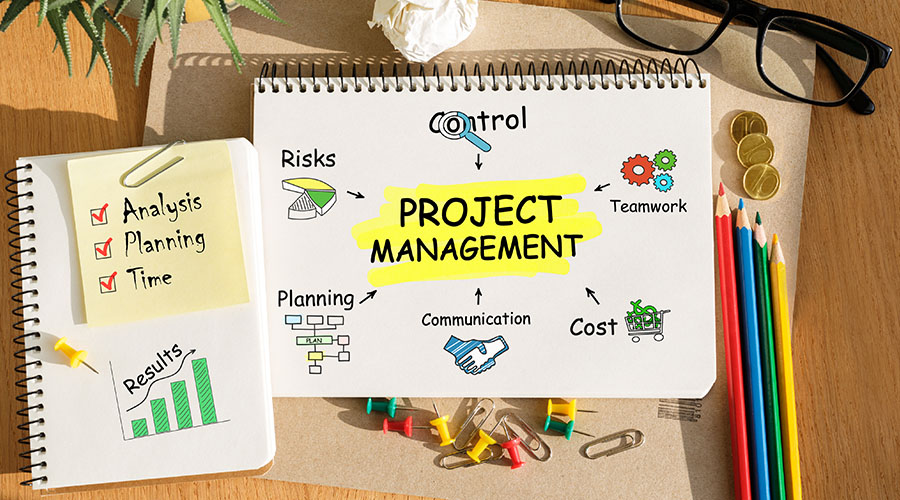There’s much to do in today’s fast-paced, competitive business world. Smart people break up their workload into a series of projects, which allows them to organize the work and make it more manageable.
But more than splitting the workload into projects is needed. After all, you need professionals to oversee or manage the projects’ progress to ensure the work is done within the allocated timeframe and budget. So, it would be best if you had a project manager. But these leaders need a defined set of project management principles to help them keep things running smoothly and according to plan.
This article explores over a dozen project management principles and practices and touches on structure, putting principles into action, PMP principles, and what defines success.
We begin with a few definitions.
What is Project Management All About?
According to the Project Management Institute (PMI), a project is “a temporary endeavor undertaken to create a unique product, service, or result.” So, a project has a starting point and a finish, and the uniqueness stems from the idea that all parts of the project are meant to contribute to a stated goal that isn’t an ongoing part of the company’s usual operations.
Projects require project management (PM), which involves applying the knowledge, skills, techniques, and tools to the activities necessary to meet the project requirements. Consequently, project management follows specific basic rules and project management principles designed to help managers lead project team members, define the project’s scope, assess risks and roadblocks, deal with changes, and maintain communication with management and stakeholders.
Also Read: Top 12 Must-Read Books for Project Management
The 13 Project Management Principles to Follow
Here are 13 project management principles every project manager should follow.
1) Define your objectives and goals. This phase is an intelligent place to start because you should know why this project exists in the first place and what constitutes success or failure. The project manager, their team, and the clients should meet and ensure everyone’s on the same page. Ideally, goals should be:
a) Realistic. Can this goal be met with the available resources and timeframe?
b) Clear. Do all parties understand what’s expected?
c) Measurable. Does the project have a set of criteria in place to judge when the goal is met?
2) Make a risk management plan. Here is another principle that should be carried out before the project even starts. First, the project manager must figure out the project’s potential risks. Although risk assessment isn’t an exact science, managers can use historical data, knowledge, and experience from the team and the stakeholders to discover likely areas where the risk lies. Project managers can use tools like a risk register template to help collect this data. In addition, risk management plans should have responses in place to resolve the issue before it escalates into a problem.
3) Define the structure of the project’s organization. Here’s another PMP principle that needs to be acted on before things get underway. The project organization’s structure is a framework that facilitates project activity planning, execution, and tracking. Project managers must create an organizational chart that spells out the project’s hierarchy and the roles of every team member. Once the organization has been established, consider what procedures and guidelines the team members must follow.
4) Define the project’s deliverables. Deliverables are unique, verifiable products, results, or capabilities to perform a service created to complete a phase, process, or project. For example, a deliverable could be a new software app, an in-house training class, or an overhaul of the organization’s database.
5) Define team roles and responsibilities. Projects succeed when everyone stays in their lane and avoids duplication of effort. Therefore, someone should clarify the roles and responsibilities and establish boundaries.
6) Establish a communication plan. Constant, clear communication keeps everyone informed and on the same page. When everyone’s talking, deviations and issues get spotted early and can be dealt with swiftly. Define who needs to know what, how that information will be relayed (meetings, regular e-mails, texts, or a mix of these) and how often someone will send these updates.
7) Establish performance baselines. Projects require project performance metrics to measure success. Performance baselines hold you and your team accountable. Therefore, you should always have the means to measure the various parts of the project and see if the measurables align with what you expected.
8) Set priorities and milestones. Priorities show you what the team should focus on, and milestones show where they are in the project’s timeline. By establishing priorities and identifying milestones, project managers will know when they’re on course and schedule. Additionally, team morale rises when you recognize milestone achievements. The project team is more motivated if there’s a means of measuring progress.
9) Develop a change management plan. Change is the only constant; this is true in every aspect of life. So, a good project manager comes prepared with a change management plan. This plan keeps track of changes, specifies how changes are handled, and establishes an approval process. A good change management plan covers changes, delays, risks, and issues involving the project’s scope, budget, and schedule.
10) Devise an initiation and execution strategy. Initiation involves the project’s preliminary work that someone must complete before any other project activities can happen. Execution typically starts with a kick-off meeting to get things underway. Project managers use the kick-off meeting to share the project’s plan and vision, delegate assignments to team members, and turn them loose on the project.
11) Be aware of time and budget limitations. Time and money are finite resources. Therefore, project managers should use project scheduling tools to establish a realistic timeline, factoring in variables such as vacations, holidays, corporate events, etc. In the same way, project managers should create a budget, including a margin for unexpected expenses.
12) Develop a process of accountability and responsibility. Great project managers empower their team members with a sense of responsibility and accountability, which pays great dividends in morale. When managers give team members responsibility for their work, it removes the burden of micro-management and allows them to work from their strengths and learn new project management skills. Both results ultimately benefit the project, the organization, and the employee. But managers must set up a means of accountability before giving team members individual responsibility. For example, managers should have tools to track project deadlines and task delegation.
13) Be transparent. Finally, project managers should create a system where all team members and other interested parties can quickly and efficiently access the project’s relevant information. Project managers who want to develop or improve project transparency should make the project’s data available to the entire team, let everyone see the big picture, provide good collaboration tools, and share calendars among relevant parties, including management and outside stakeholders, if appropriate. Project transparency removes guesswork and uncertainty and leads to better team and project results.
If you want a different perspective, look at these agile project management principles and see where the two sets of principles mesh and where they deviate.
Also Read: What is a Project Management Office? A Beginner’s Guide
Put Principles into Action Using Templates and Software
Fortunately, many resources are available to help managers implement project management principles and practices. For example, you can employ project budget templates, project plan templates, and Gantt chart templates. The last chart is handy, as it lets you identify critical paths, set milestones, set up task dependencies, and collaborate with your team, all in real-time.
Additionally, project managers can benefit from a good project management software solution such as:
1) Monday.com
2) Smartsheet
3) ProjectManager
4) ClickUp
5) Wrike
All About Project Structure
A good project structure is made up of work packages. These work packages represent enclosed work units assigned to the proper personnel. Therefore, when creating the layout for your project, you must consider three primary factors.
1) The Project’s Goal. Ask yourself, “What is this project trying to accomplish?” When you answer that question, you have a better understanding of what must be done, which then determines your project’s goals.
2) The Project’s Milestones. Milestones help split the project into phases or steps, each with defined demands and results.
3) The Project’s Timeline. The timeline defines the project’s starting and ending points and the order of the work packages. This information is best rendered into a flowchart.
What Constitutes Project Success?
There isn’t a single correct answer to this question. Project success means different things depending on who you ask. However, success is best expressed at the start of the project using key and measurable criteria to judge the project’s success or failure. These criteria can include the following:
1) Meeting essential project objectives such as the organization, stakeholder, or user’s business objectives.
2) Creating satisfaction with the entire project management process. This satisfaction can be based on factors such as a complete deliverable that meets the organization’s standards and is completed on time and within budget.
3) The project’s customers and most of the project’s community are satisfied with and accept the project’s deliverables.
Also Read: AI for Project Management: Creating More Efficiency, Accuracy, and Better Results
How Would You Like Project Management Certification?
We mentioned building upon your newly gained CAPM certification to improve your project management skill set by taking other certification courses. For example, Simplilearn, in collaboration with the University of Massachusetts, offers a PMP boot camp to boost your project leadership skills and prepare you to take on more significant challenges and better career opportunities.
The boot camp, aligned with PMI-PMP® and IASSC-Lean Six Sigma, covers valuable project management skills such as:
- Agile Management
- Customer Experience Design
- Design Thinking
- Digital Transformation
- Leadership Skills
- Lean Six Sigma Green Belt (LSSGB)
- Project Management
- Project Risk Management
In addition, the bootcamp helps you earn your 146 Professional Development Units (PDUs) to maintain your continuing certification requirements (CCR) for PMI-related certifications. You will also be offered membership in the UMass Amherst Alumni Association.
Today’s business world needs more qualified project management professionals than ever. So, sign up for this valuable project management bootcamp today, and turbocharge your project manager career while opening more doors and career opportunities.
You might also like to read:
Exploring Top AI Project Management Tools
How to Negotiate the Best Project Manager Salary
What is Enterprise Resource Planning, And How Does It Help Organizations?
What Are Network Diagrams in Project Management, and Why Are They Effective?







